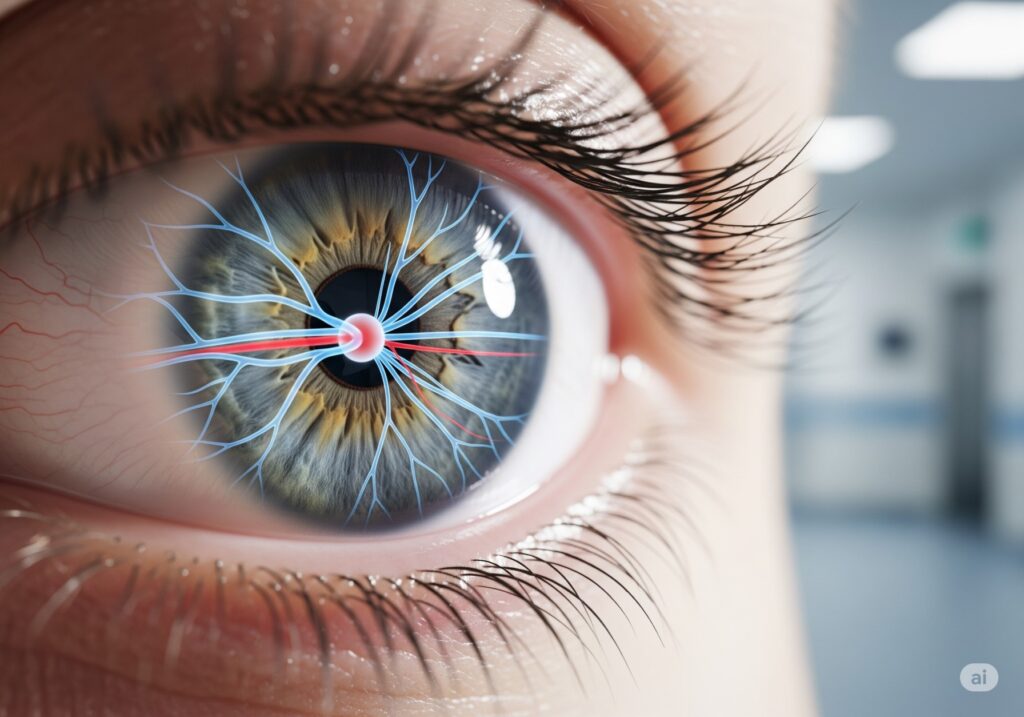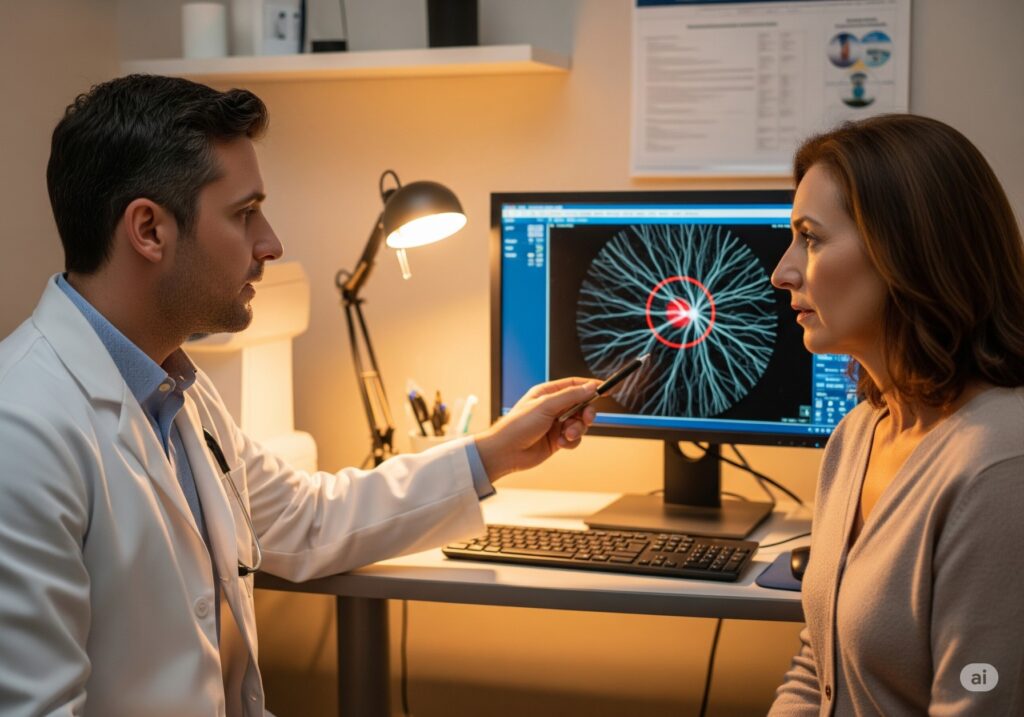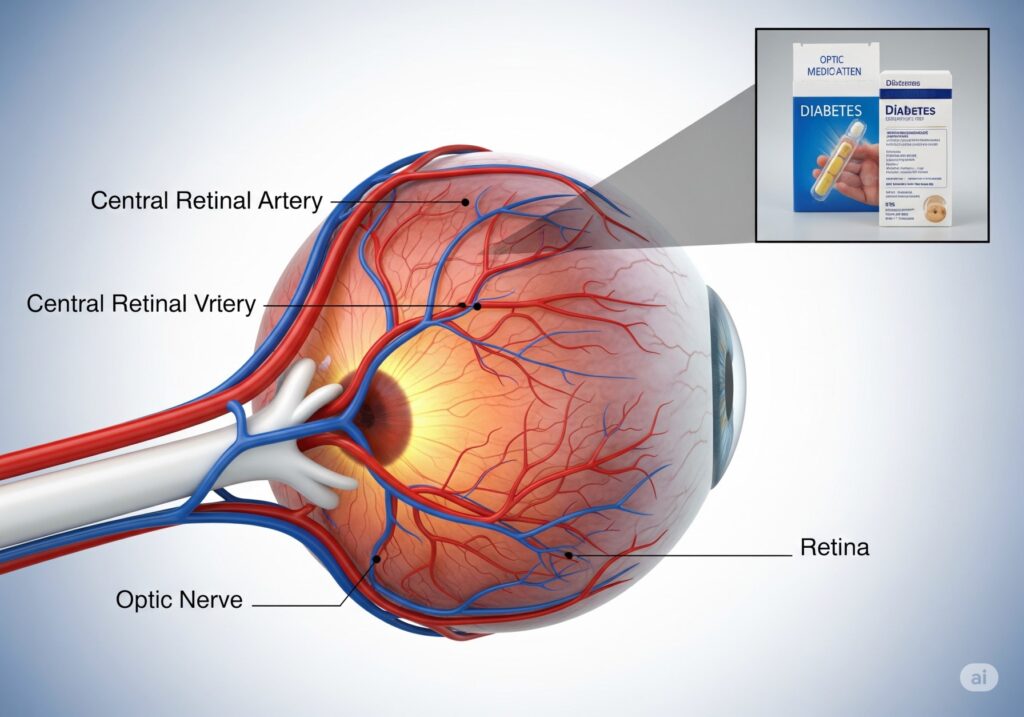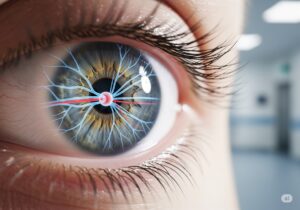
Diabetes drugs optic nerve damage illustration in human eye
New studies link some diabetes drugs to rare optic nerve damage (NAION). Learn the risks, symptoms, and what patients should do next.
Diabetes drugs optic nerve damage: what to know
GLP-1–based diabetes and weight-loss medicines have changed care for millions. Yet new research links some of these diabetes drugs to optic nerve damage, specifically a rare condition called non-arteritic anterior ischemic optic neuropathy (NAION). The risk is small. Still, it matters. Here’s what the latest evidence and regulators say—and what you can do next. JAMA Network, Mass Eye and Ear
What is NAION—and why it matters
NAION is an “eye stroke” of the optic nerve. Blood flow drops. Vision can suddenly blur or dim, usually in one eye, and it’s painless. Incidence in adults over 50 is low—roughly 2 to 10 cases per 100,000 people per year—but the vision loss can be permanent. American Academy of Ophthalmology
Want a deeper dive? The American Academy of Ophthalmology has a good overview of NAION and how doctors diagnose it: https://www.aao.org/eyenet/article/naion-diagnosis-and-management. American Academy of Ophthalmology
What the new research found about diabetes drugs and optic nerve damage

Several studies in 2024–2025 reported an association—though not proof of causation—between semaglutide (the active ingredient in Ozempic, Wegovy, and Rybelsus) and NAION. A large study from Mass Eye and Ear, published in JAMA Ophthalmology in July 2024, observed a higher rate of NAION among patients prescribed semaglutide compared with those on other diabetes or weight-loss drugs. Read the study here: https://jamanetwork.com/journals/jamaophthalmology/fullarticle/2820255 and the research summary here: https://masseyeandear.org/news/press-releases/2024/07/prescription-weight-loss-drugs-linked-to-blinding-condition. JAMA Network, Mass Eye and Ear
Since then, additional analyses have refined the picture. A 2025 multicenter study suggested the risk increase may be modest and smaller than first reported, while still warranting caution and more research. See the abstracts on PubMed and American Journal of Ophthalmology: https://pubmed.ncbi.nlm.nih.gov/39976940/ and https://www.sciencedirect.com/science/article/pii/S0002939425000947. PubMed, ScienceDirect
What regulators now say
Regulators have weighed in. In June 2025, Europe’s medicines committee (PRAC) concluded NAION is a very rare side effect of semaglutide and recommended updating product information. The guidance: if vision suddenly worsens during treatment, contact a doctor immediately and consider stopping the drug if NAION is confirmed. Details: https://www.ema.europa.eu/en/news/prac-concludes-eye-condition-naion-very-rare-side-effect-semaglutide-medicines-ozempic-rybelsus-wegovy. The World Health Organization also issued a safety alert summarizing the change: https://www.who.int/news/item/27-06-2025-27-06-2025-semaglutide-medicines-naion. European Medicines Agency (EMA), World Health Organization
The American Academy of Ophthalmology’s public guidance, published after the 2024 study, noted the signal involves semaglutide specifically and urged patients to discuss risks and benefits with clinicians rather than abruptly stopping therapy: https://www.aao.org/newsroom/news-releases/detail/weight-loss-drug-and-eye-health. American Academy of Ophthalmology
How big is the risk?

Even in higher-risk groups, NAION remains uncommon. Most estimates place annual incidence between about 2 and 10 per 100,000 people over age 50. That baseline helps put any drug-related increase in context: a relative increase may still translate to a very small absolute risk. American Academy of Ophthalmology
Importantly, findings are associations, not proof that the medicines directly cause NAION. Confounding factors—diabetes itself, blood pressure changes, sleep apnea, optic-disc anatomy, and vascular risk—also influence NAION risk. Ongoing studies are testing how much each factor contributes. Frontiers
Balancing benefits and risks
GLP-1–based drugs provide major benefits: better blood sugar control, meaningful weight loss, and lower cardiovascular risk in many patients. For most, those benefits will outweigh the very rare potential for optic nerve damage. That’s why regulators updated labels rather than withdrawing the medicines. Talk to your care team before making changes. Wiley Online Library
Spotting symptoms early: what to watch for
Because NAION often happens suddenly, time matters. Call your doctor or seek urgent eye care if you notice:
- Sudden vision loss or a shadow in one eye
- Rapidly worsening blurred or dim vision
- Loss of part of your visual field
These are the red-flag symptoms highlighted in regulatory guidance: https://www.ema.europa.eu/en/news/prac-concludes-eye-condition-naion-very-rare-side-effect-semaglutide-medicines-ozempic-rybelsus-wegovy. European Medicines Agency (EMA)
Practical steps if you’re using diabetes drugs, optic nerve damage is a concern
Talk to your prescriber first
Do not stop medication on your own. Ask how your personal risk stacks up given age, eye anatomy, diabetes duration, blood pressure patterns (including nighttime levels), and sleep apnea. A brief risk review can be part of routine follow-up. See background risk factors here: https://www.frontiersin.org/journals/medicine/articles/10.3389/fmed.2021.618353/full. Frontiers
Schedule an eye exam—and repeat it
A baseline dilated exam helps. If you recently started semaglutide, consider an earlier check-in, especially if you already have vascular risk factors or a “crowded” optic disc. Learn more from AAO resources: https://www.aao.org/eyenet/article/naion-diagnosis-and-management. American Academy of Ophthalmology
Manage the basics, too
Control blood sugar, blood pressure, and lipids. Treat sleep apnea if present. These foundational steps may reduce overall eye and vascular risks, regardless of which diabetes drug you use. Evidence summaries: https://www.frontiersin.org/journals/medicine/articles/10.3389/fmed.2021.618353/full. Frontiers
Where the science is heading next
Research is moving quickly. Some analyses suggest a stronger signal; others suggest a smaller one. Different study designs, populations, and confounder controls explain part of the variation. Expect more real-world data and mechanistic studies to refine the risk estimate and identify which patients—if any—carry disproportionate risk. Keep an eye on updates from journals like JAMA Ophthalmology and agencies such as the EMA and WHO:
- JAMA Ophthalmology 2024 study: https://jamanetwork.com/journals/jamaophthalmology/fullarticle/2820255
- 2025 follow-up analyses: https://pubmed.ncbi.nlm.nih.gov/39976940/ and https://www.sciencedirect.com/science/article/pii/S0002939425000947
- EMA safety update: https://www.ema.europa.eu/en/news/prac-concludes-eye-condition-naion-very-rare-side-effect-semaglutide-medicines-ozempic-rybelsus-wegovy
- WHO medical product alert: https://www.who.int/news/item/27-06-2025-27-06-2025-semaglutide-medicines-naion JAMA Network, PubMed, ScienceDirect, European Medicines Agency (EMA), World Health Organization
Bottom line on diabetes drugs: optic nerve damage
- A rare optic nerve stroke (NAION) has been linked to semaglutide in observational studies.
- Regulators now list NAION as a very rare side effect on semaglutide labels in Europe.
- The absolute risk for any one person is low; benefits often outweigh risks.
- However, do not ignore sudden vision changes—seek urgent care.
- Discuss your individualized plan with your doctor, and schedule regular eye exams. JAMA Network, European Medicines Agency (EMA)
Medical information here is educational and not a substitute for professional advice. Always consult your clinician about your treatment.
Disclaimer
This content is for general information only and should not replace professional medical advice. If you notice sudden vision changes while on diabetes medication, seek urgent medical care.
Protect your vision
Talk to your doctor about your risks, keep up with regular eye exams, and share this article to help others stay informed.





